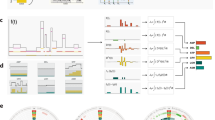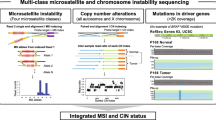Summary
We have measured genomic instability in invasive breast carcinomas and assessed the relationship of genomic instability to known tumor prognostic factors. DNAs from tumors and adjacent normal tissue of 18 breast cancer patients were subjected to inter-Simple Sequence Repeat (inter-SSR) PCR for quantitation of tumor genomic instability. Associations between genomic instability level and known breast cancer prognostic factors were evaluated using the Pearson Product Moment Correlation, the Kruskal–Wallis test of independent samples and the Mann–Whitney non-parametric test. Genomic instability was detected by inter-SSR PCR in over 90% of the breast tumors. The mean instability index was 3.08% (0–7.59%), approximately the same mean value observed in studies of colorectal and thyroid carcinomas. Significantly higher levels of instability were associated with tumors exhibiting necrosis. Genomic instability as measured is detected in the majority of breast cancers at levels comparable to other tumor types. Hypoxia, such as that observed in necrotic regions of tumors, has been associated with elevated genomic damage. We hypothesize that the higher levels of genomic instability detected in necrotic tumors is a consequence of hypoxia-associated DNA damage.
Similar content being viewed by others
References
Anderson GR, Stoler DL, Brenner BM, 2001 Cancer: the evolved consequence of a destabilized genome BioEssays 23: 1037–1046
Hanahan D, Weinberg RA, 2000 The hallmarks of cancer Cell 100: 57–70
Fearon ER, Vogelstein B, 1990 A genetic model for colorectal tumorigenesis Cell 61: 759–767
Renan MJ, 1993 How many mutations are required for tumorigenesis? Implications from human cancer data Mol Carcinogen 7: 139–146
Loeb LA, 1991 Mutator phenotype may be required for multistage carcinogenesis Cancer Res 51:3075–3079
Jackson AL, Loeb LA, 1998 The mutation rate and cancer Genetics 148: 1483–1490
Loeb LA, 2001 A mutator phenotype in cancer Cancer Res 61: 3230–3239
Greenlee RT, Murray T, Bolden S, Wingo PA, 2000 Cancer Statistics, 2000 CA Cancer J Clin 50: 7–33
Alberg AJ, Singh S, May JW, Helzlsouer KJ, 2000 Epidemiology, prevention and early detection of breast cancer Curr Opin Oncol 12: 515–520
Wolff AC, Davidson NE, 2000 Primary systemic therapy in operable breast cancer J Clin Oncol 18: 1558–1569
Basik M, Stoler DL, Kontzoglou KC, Rodriguez-Bigas MA, Petrelli NJ, Anderson GR, 1997 Genomic instability in sporadic colorectal cancer quantitated by inter-(simple sequence repeat) PCR analysis Gene Chromosome Canc 18: 19–29
Winer EP, Morrow M, Osborne CK, Harris JR, 2001 Malignant tumors of the breast. In:DeVita VT, Hellman S, Rosenberg SA, eds. Cancer: Principles and Practice of Oncology, 6, Williams & Wilkins, Philadelphia, PA: Lippincott, pp 1651–1716
Przybytkowski E, Girouard S, Allard B, Lamarre L, Basik M, 2003 Widespread bimodal intrachromosomal genomic instability in sporadic breast cancers associated with 13q allelic imbalance Cancer Res 63:4588–4593
Stoler DL, Chen N, Basik M, Kahlenberg MS, Rodriguez-Bigas MA, Petrelli NJ, Anderson GR, 1999 The onset and extent of genomic instability in sporadic colorectal tumor progression Proc Natl Acad Sci USA 96: 15121–15126
Wiseman SM, Loree TR, Rigual NR, Hicks WL Jr, Winston JS, Swede H, Bartos JD, Anderson GR, Stoler DL, 2003 Papillary thyroid cancer: high inter-(simple sequence repeat) genomic instability in a typically indolent cancer Head Neck 25:825–832
Thomlinson RH, Gray LH, 1955 The histological structure of some human lung cancers and the possible implications for radiotherapy Brit J Cancer 9: 539–549
Russo CA, Weber TK, Volpe CM, Stoler DL, Petrelli NJ, Rodriguez-Bigas M, Burhans WC, Anderson GR, 1995 An anoxia inducible endonuclease and enhanced DNA breakage as contributors to genomic instability in cancer Cancer Res 55:1122–1128
Reynolds TY, Rockwell S, Glazer PM, 1996 Genetic instability induced by the tumor microenvironment Cancer Res 56: 5754–5757
Nelson DA, Tan TT, Rabson AB, Anderson D, Degenhardt K, White E, 2004 Hypoxia and defective apoptosis drive genomic instability and tumorigenesis Genes Dev 18:2095–2107
Acknowledgements
This work was supported by American Cancer Society Grant No. RPG-98-192-01-CNE (DLS) and NIH grant RO1 CA74127(GRA), and partially supported by shared resources of the Roswell Park Cancer Center support Grant P30 CA16056. We thank Nancy Watroba for her invaluable assistance in collecting patient data.
Author information
Authors and Affiliations
Additional information
Daniel L. Stoler, Jeremy D. Bartos, and Helen Swede all contributed equally to this manuscript
Rights and permissions
About this article
Cite this article
Stoler, D.L., Bartos, J.D., Swede, H. et al. Genomic instability in invasive breast carcinoma measured by inter-Simple Sequence Repeat PCR. Breast Cancer Res Treat 97, 107–110 (2006). https://doi.org/10.1007/s10549-005-9092-9
Published:
Issue Date:
DOI: https://doi.org/10.1007/s10549-005-9092-9




